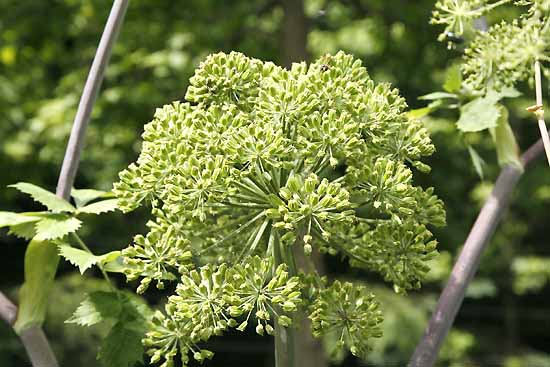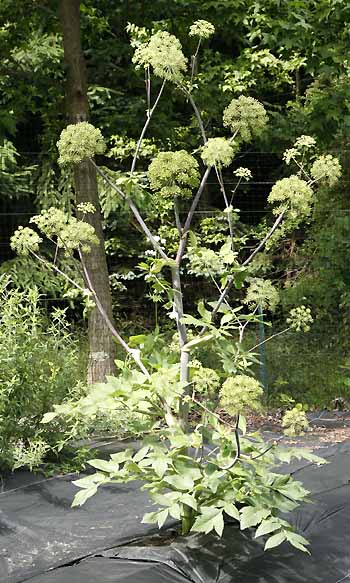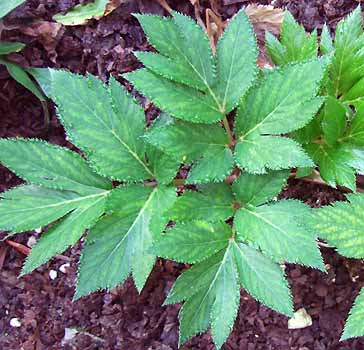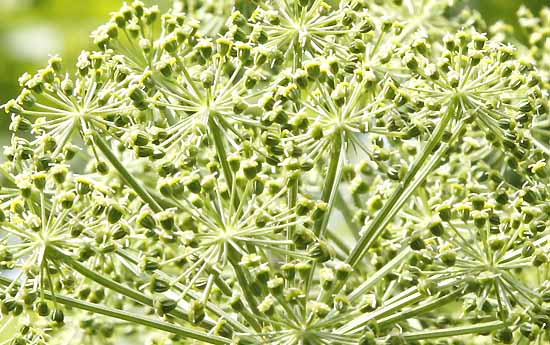Angelica is a large impressive aromatic biennial plant for shady moist locations. It will grow in full sun in zones higher than 6 but some shade from full day sun is desirable. Loves rich moist soil. It produces large aromatic green leaves and in second or third year flower spikes up to six feet high with globular green flower clusters 6 inches in diameter. Almost the whole plant is edible. Easy to grow once established. Wildlife especially deer love to eat it so it needs protection. Adds great drama to the garden even if not for eating.
Description of Angelica (Angelica archangelica)
Angelica is a large biannual sometimes triennial plant. In the first year it
produces a small clump of mid green compound leaves that usually reach only
about 2 feet (64 cm)in height. It is during this year that the main root forms.
First year Angelica roots can become very large often weighing as much are three
pounds. They are long, spindle shaped, thick and fleshy with many long, descending
rootlets. During the second year, or sometimes the third year depending on growing
conditions the plant produces much larger compound leaves that can be up to
2- 3 feet (64 -70 cm) in length and about 1/3 as wide with largest leaflets
at the base of the compound leaf. The leaves are bold bright to mid green deeply
cut with fine serrated edges and bold veins. In mid summer it sends up thick
hollow stems that can rise to 6 feet (2 m) and are branched with far fewer small
leaves. At the end of each branch is a flower head in the shape of a globe up
to 6 inches (10-14 cm) across and composed of dozens of small greenish flowers
with small white protruding stamens. These are followed by greenish yellow fruits
that turn brown when ripe. In most cases the whole plant then dies. In ideal
conditions the plant will produce side shoots which continue to live on when
the mother plant dies. The whole plant is highly aromatic unique to the plant,
some say juniper others licorice. It is hardy to zone 4 and is not frost tender.
Location and Care of Angelica (Angelica archangelica)
Angelica prefers deep moist loam in a shady position. It much prefers a slightly
acidic soil but will tolerate a range of pH. It thrives best in damp soil and
likes to grow near running water. Angelica is a very tough plant and will grow
in quite cold conditions. In zones 5 and above it can tolerate more full sunshine
and zone four it will easy grow in the open. In warmer zones (6-7) some sunshine
is acceptable lower zones need mostly shade. This plant will not do well in
very warm zones and is not recommended for 8 and higher. In most zones growing
in some shade is necessary. Under deciduous trees or on the north side of buildings
or on the north side of a screen of trees or tall hedge. Ensure it has shade
from the noon sun and is in a location which although screened will allow cooling
airflow. The plant can survive in full sun but it most likely wont flower.
Angelica needs a lot of organic material to flower well. Almost any soil type
will do if the organic material is added in enough quantity and the plant is
well watered. Running a soaker hose along the base of the plants is a good way
to keep them moist if soil is not naturally damp. Do not allow the soil to completely
dry out.
Angelica does not like to be transplanted due to the large roots that it creates.
Pick your location well and allow plenty of room of the plants to grow into.
Transplanting once the plant has begun to grow well usually ends in plant death.
If leaf production is required the flowering stems can be cut off. In
Pest Problems with Angelica (Angelica archangelica).
This plant tends to be pretty hardy and does not have that many
pests. It can
attract aphids, red spider mites and leaf miners (less common) but the flowers
also attract a mirid of native insects which also prey on these pests so most
often they don't stay on the plants long and can be left for the 'locals' to
clean up.
Roots can be the main problem. Many rodents such as voles and mice will eat
the roots during the winter months it they have the ability to get to them.
This can occur with snow is on the ground but enough melting has occurred for
the rodents to move around under the snow. They can burrow into the soil around
the roots, or more commonly used the tunnels created by moles to reach and devour
the roots. Controlling moles or using mole repellent is the best option for
control.
Growing Angelica from Seed.
Seed needs to be fresh and kept under cold conditions as Angelic seed does not
remain viable for too long. (all of our seed is collected and immediately cold
stored for the best freshness. Only the previous seasons seed is sold).
Seeds need light to germinate. Although germination rates tend to be
low they are made lower because many people cover the seeds.
Seeds can be sown in place in the autumn/fall or sown in pots during the late
winter. We recommend the latter since surface sown seeds are more susceptible
to predation by hungry wildlife.
Seeds are large so planting 2-3 in individual pots or using large cell seeding
trays is recommended. This way seedlings can be removed without disturbing as
yet ungerminated seeds. Do not cover seeds. Keep constantly moist until
the seeds germinate, best temperature is around 65 F (18°C). Transplant
when the seedlings are large enough to handle and plant on into their own pots.
Grow on until plants are large enough, then harden off outside in shady location
before transplanting to final location. Since angelica produces large roots
ensure that all the soil is moved with the plant and keep root disturbance to
a minimum. Plant at least 3 feet (1m) apart.
Harvesting Angelica. (Angelica archangelica)
Some leaves can be picked during the first (rosette) season of the plant, but
don't take too many as the plant is using is resources to make the large thick
roots.
Leaf harvest is best done from early second year plants before they begin
to flower. IF the flower stalks are cut off the plant can be persuaded for many
years, often becoming more of a perennial. However in warmer zones this can
only be continued for a few years before the plant tends to die. Allowing the
plant to flower at the end of 4-5 years is the best option. For best results
harvest leaves until the plant flowers then allow it to seed.
Fruit harvest, cut when they are still green before they ripen.
Seeds. Leave on the plant until they turn brown. For culinary use ensure
seeds are totally dry before storing in sealed containers in cool dry area.
For seeds to plant, collect seed and immediately refrigerate until seeding is
desired.
Stems. Can be harvested while still young but large enough to handle.
These can be dried, candied or eaten as vegetables.
Roots. Best dug at the end of the first year when they are at their largest.
Roots can be quite large and sometimes difficult to dig up. Roots can be used
fresh or immediately dried for later use.
Culinary Use of Angelica
The whole plant is edible, leaves, stems, seeds and roots. It is often eaten
as a vegetable in Northwest Europe and Siberia. The peeled stalks can be eaten
raw with a dip like celery. They can also be cooked and used either as a side
dish or on any other dish that requires vegetables. Stalks can also be candied
for use in confectionary. The whole
plant has a mildly licorice flavor.
Medicinal Use of Angelica (Angelica archangelica).
There are many varieties of Angelica, but Angelica archangelica is the only
one officially employed in medicine. It is especially useful for treating digestive
disorders and blood circulation. The roots is the most active medicinal part
and retains is use for many years. Leaves and seeds can also be used. Infusions
are used to treat flatulence, indigestion, chronic bronchitis and typhus. It
has been shown to stimulate blood flow in peripheral parts of the body (such
as fingers and toes) and is used to treat poor circulation. However it should
not be used for those with a tendency towards diabetes since its use can increase
sugar levels in the urine.
Other names.
angelica, garden angelica, Norwegian angelica, Holy Ghost, archangel, Angelica
officinalis









